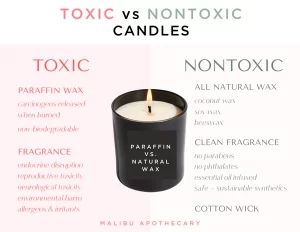
https://www.everydayhealth.com/healthy-living/are-scented-candles-harmful-to-your-health/
Introduction
These days people are celebrating Christmas and New Year parties. Candles are used as decorations at these parties and to release relaxing fragrances. These modern candles are made from paraffin wax. These candles are made from beeswax, soy wax or palm wax. Scented candles have long been cherished for their ability to transform a space with delightful fragrances creating a cozy and inviting atmosphere. However, beyond their aromatic allure, recent studies have raised concerns about the potential hazards associated with these popular home accessories.
There is ongoing debate regarding the potential health effects of burning candles. Certain individuals argue that candles emit potentially harmful toxins, while others counter that the level of these toxins is insufficient to pose a health threat. In this exploration, we will delve into scientific findings on burning candles to discern the facts from prevalent misconceptions.

https://malibuapothecary.com/blogs/clean-candles/are-scented-candles-toxic
Emission Of Harmful Chemicals
Many scented candles contain synthetic fragrance, which, when burned, releases a cocktail of chemicals into the air. These include volatile organic compounds such as benzene and formaldehyde, which can hurt indoor air quality. Prolonged exposure to these chemicals may contribute to respiratory issues and other health concerns.
Particulate Matter concerns
The act of burning candles generates particulate matter, tiny particles that can become airborne. Inhaling high levels of particulate matter, tiny particles that can become airborne. Inhaling high levels of particulate matter has been linked to respiratory and cardiovascular problems. Individuals with pre-existing conditions such as asthma, may be particularly vulnerable to the health impacts of these particles.
Metal-Core Wicks And Potential Lead Exposure:
Certain candles, especially those with metal-core wicks, may pose a risk of lead exposure. When burned, these candles release lead into the air, presenting a health hazard. Exposure to lead is associated with neurological and developmental issues, making it cause for concern, especially in households with children.
Allergies And Respiratory Sensitivities
The fragrance used in scented candles can trigger allergic reactions and exacerbate respiratory sensitivities. Ashthama sufferers and individuals with allergies to specific scents may experience symptoms such as wheezing, coughing or nasal congestion when exposed to these fragrances.
Candles Additives and Unknown Ingredients
Certain candle wax may contain additives or dyes that, when burned, release additional unknown chemicals into the air. The potential health impacts of these additives are not well-studied, raising questions about the long-term consequences of regular exposure.
Minimizing Risk and Making Informed Choices
While the allure of scented candles is undeniable, it’s essential to be aware of the potential hazards and take steps to minimize risks. Opting for candles made from beeswax or soy, which produce fewer toxins and choosing those scented with essential oils instead of synthetic fragrances are positive steps.
Ventilating spaces where candles are burned, avoiding candles with metal-core wicks, and being cautious about candle additives contribute to safer usage, Additionally individuals with respiratory conditions sensitivities may want to explore alternative options, such as essential oil diffusers or unscented candles.
Conclusion
In conclusion, scented candles can enhance the sensory experience of a space. Consumer should approach their use with caution and awareness of potential health risks. Making informed choices ensures that the warm glow of candlelight doesn’t compromise the well-being of those enjoying it.
References:

 Hobbies: The Power Of In Refreshing Mood
Hobbies: The Power Of In Refreshing Mood Millets : Adapt Millet In Your Life Style
Millets : Adapt Millet In Your Life Style Diabetes Supplements: A Comprehensive Guide
Diabetes Supplements: A Comprehensive Guide


